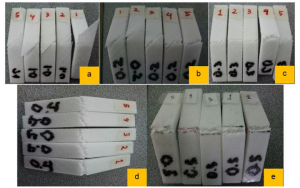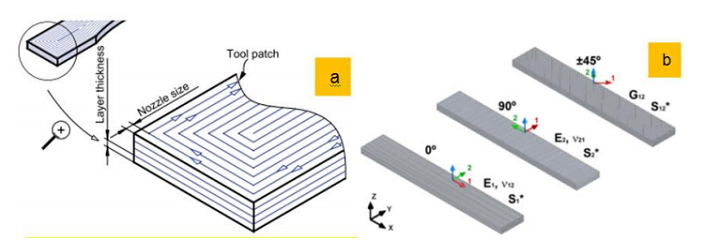Researchers Study Effects of Layer Thickness on 3D Printed PLA Samples
A group of researchers from the National Institute of Aeronautics and Space (LAPAN) in Indonesia worked on the mechanical characterization (flexural properties) of biodegradable PLA materials produced by extrusion-based 3D printing methods (FDM, Fused Deposition Modeling, FFF). Plenty of research has been done on various 3D printing parameters, and this research team chose to focus on the effect of various layer thicknesses of 3D printed PLA on flexural properties in their new paper, titled “Effect of layer thickness of flexural properties of PLA (PolyLactid Acid) by 3D printing.”
The abstract reads, “The study begins from manufacture the solid 3D model based on the ASTM standards for flexural properties test of the material using Three-point bending method. Three-point bending test was conducted with Tensilon Universal Testing Machine – AND RTF-2410 with a 100kN load cell, specimen shape and size according to standard size ASTM D 790. The result shown that the layer thickness had an effect on flexural strengths of PLA samples. The maximum flexural strengths from Lt = 0.4 to 0.5mm were significantly increase. Moreover, it is worth nothing that ductility decreased as layer thickness increased. According to test result that the maximum flexural strength occurred at 0.5 mm layer thickness with 59.6 MPa and the minimum flexural strength occurred at 0.1 mm layer thickness with 43.6 MPa. The higher layer thickness tended to promote higher strength. The thicker layer is the stronger layer bond in holding the load bending. In this study the thicker layer have tendend to shown a 90-degree delamination fracture and the thinner layer have tendend to shown a 45-degree delamination fracture according to the direction of printing is ± 45°.”
The team quoted other researchers in noting that while “layer thickness has been studied extensively, it should be further analyzed” because of the disparity of the results regarding features like tensile strength and flexural strength.
“The objectives of this research is to know the influence of layer thickness {0.1, 0.2, 0.3, 0.4, 0.5} mm on flexurel properties of PolyLactid Acid (PLA) 3D printing,” the researchers wrote.
The researchers set out to analyze the flexural performance of samples 3D printed out of commercial 1.75 mm PLA filament on a desktop FDM50-5050 3D printer by ZBOT.CC. Three-point bending tests were conducted to determine the 3D printed samples’ flexural response in terms of strength and stiffness.
“In this study, a solid sample was filled with a raster perimeter analyzed, in which the tool path was offset from the perimeter with a distance equivalent to the nozzle size,” the researchers explained.
The results show that the PLA materials’ flexural strength was in fact significantly affected by the layer thickness of the 3D printed samples.
“Layer thickness is directly related to the number of layers needed to print a part and hence to printing time,” the researchers wrote.
“Each specimen has the same thickness of 4mm, but the layer thickness of the specimen is different from {0.1, 0.2, 0.3, 0.4 and 0.5}mm to get a thickness of 4mm. The load maximum received by the specimen is different for each specimen so that the value of the flexural strength is also different. The effect of layer thickness on the flexurel properties was different for each sample. In this case, higher layer thickness tended to promote higher strength. These results were in accordance with previous works with PLA.”

Fracture characteristics of PLA samples with different layer thickness: (a) 0.1mm, (b) 0.2mm, (c) 0.3mm, (d) 0.4mm, (e) 0.5mm.
Their results showed that, in terms of upright orientation, flexural and tensile strengths both increased as the layer thickness increased, and that the higher the layer thickness, the higher the strength.
“The thicker layer is the stronger layer bond in holding the load bending,” the researchers concluded. “In this study the thicker layer have tendend to shown a 90-degree delamination fracture and the thinner layer have tendend to shown a 45- degree delamination fracture according to the direction of printing is ± 45°.”
In the future, the researchers plan to study the effects of build orientation, feed rate, and tool patch on the mechanical properties of 3D printed parts.
Co-authors of the paper are A. Nugroho, R. Ardiansyah, L. Rusita and I. L. Larasati.
Discuss this research and other 3D printing topics at 3DPrintBoard.com or share your thoughts below.
Subscribe to Our Email Newsletter
Stay up-to-date on all the latest news from the 3D printing industry and receive information and offers from third party vendors.
Print Services
You May Also Like
Low-cost “Suzy” Polymer Powder 3D Printer is Faster and Cheaper than Past Models
Polish laser powder bed fusion (LPBF) firm Sinterit has released a follow-up to its predecessors, Lisa and Nils, called Suzy, a $19,490 printer equipped with a 30W fiber diode laser....
India’s $58M Space Fund Is a Boon for AM Innovation
India’s space industry is picking up serious momentum. With a projected $44 billion space economy by 2033, the country is aggressively expanding its capabilities, fostering private-sector participation, and reducing its...
Japanese Advanced Manufacturing Capabilities Grow in Europe with Sodick’s Purchase of Prima Additive
The global economy is currently undergoing a reshuffling in terms of what gets manufactured where. In large part, this trend is being driven by new geopolitical alliances and the need...
Bosch Invests €6M into Serial Auto Part 3D Printing
German industrial conglomerate Robert Bosch GmbH, the world’s largest supplier of automotive parts, has announced a new investment into Nuremberg, Germany additive manufacturing (AM) facility. The nearly €6 million in...





























